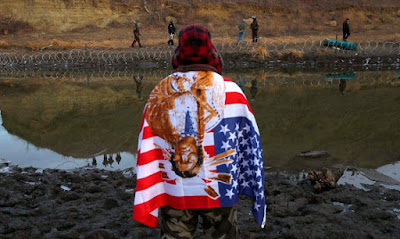US CANADA INFRASTRUCTURE CRISIS THE SAME
Lawmakers Are Worried ISPs Can't Deliver on Their Rural Broadband Promises
Last week, 160 members of Congress sent a letter to the FCC raising concerns about some Rural Digital Opportunity Fund (RDOF) winners’ ability to provide rural America with the broadband access they promised. The letter did not call out individual internet service providers or organizations by name, but it did call on the FCC to “redouble its efforts to review the long-form applications” auction winners must provide as the last step to access their funds.

© Photo: Scott Olson (Getty Images) A farmer drives a tractor
down a rural road on Jan. 17, 2019 near Ottawa, Ill.
“Transparency and accountability must be part and parcel of the administration of any program, and we urge you to thoroughly vet the winning bidders to ensure that they are capable of deploying and delivering the services they committed to providing,” said the letter.
The Congressional letter-signers have asked the FCC to do a thorough review of all grant recipients to make sure every one has the “technical, financial, managerial, operational skills, capabilities, and resources” to roll out internet to under and unserved areas of rural America. Could a company like SpaceX or Frontier manage such an ambitious task?
Lawmakers have also asked the FCC to better assess every single recipient of the RDOF Phase I auction, which the agency held last month. ISPs like Frontier and CenturyLink have missed FCC-mandated deadlines to roll out more broadband to rural America with money they received from the Connect America Fund Phase II grants in 2015. Both companies received a combined total of $633.3 million from the RDOF Phase I auction last month, which will be distributed over the next 10 years.
One of the fund recipients, the National Rural Electric Cooperative Association (NRECA), supports the lawmakers’ call for a better and more transparent long-form application review process. Electric co-ops snatched a total of $1.6 billion in funds to expand broadband access in the communities they serve. The NRECA is national trade association representing nearly 900 local electric cooperatives, with a focus on environmental protection and broadband access, among several other issues.
In fact, it was the NRECA that urged lawmakers to send that letter in the first place.
“Many of the winning applicants claim they will deliver levels of service with certain technologies that are only achievable in extremely limited conditions and terrain—or still not commercially available,” said Kelly Wismer, NRECA’s lobbyist on broadband issues.
The letter also calls on the FCC to “make as public as possible the status of its review and consider opportunities for public input on the applications.”
If the FCC agrees to such a review process, that means the public would have a chance to weigh in on the likes of Frontier, CenturyLink, SpaceX, and other internet providers actually getting a piece of the RDOF.
“Transparency and accountability must be part and parcel of the administration of any program, and we urge you to thoroughly vet the winning bidders to ensure that they are capable of deploying and delivering the services they committed to providing,” said the letter.
The Congressional letter-signers have asked the FCC to do a thorough review of all grant recipients to make sure every one has the “technical, financial, managerial, operational skills, capabilities, and resources” to roll out internet to under and unserved areas of rural America. Could a company like SpaceX or Frontier manage such an ambitious task?
Lawmakers have also asked the FCC to better assess every single recipient of the RDOF Phase I auction, which the agency held last month. ISPs like Frontier and CenturyLink have missed FCC-mandated deadlines to roll out more broadband to rural America with money they received from the Connect America Fund Phase II grants in 2015. Both companies received a combined total of $633.3 million from the RDOF Phase I auction last month, which will be distributed over the next 10 years.
One of the fund recipients, the National Rural Electric Cooperative Association (NRECA), supports the lawmakers’ call for a better and more transparent long-form application review process. Electric co-ops snatched a total of $1.6 billion in funds to expand broadband access in the communities they serve. The NRECA is national trade association representing nearly 900 local electric cooperatives, with a focus on environmental protection and broadband access, among several other issues.
In fact, it was the NRECA that urged lawmakers to send that letter in the first place.
“Many of the winning applicants claim they will deliver levels of service with certain technologies that are only achievable in extremely limited conditions and terrain—or still not commercially available,” said Kelly Wismer, NRECA’s lobbyist on broadband issues.
The letter also calls on the FCC to “make as public as possible the status of its review and consider opportunities for public input on the applications.”
If the FCC agrees to such a review process, that means the public would have a chance to weigh in on the likes of Frontier, CenturyLink, SpaceX, and other internet providers actually getting a piece of the RDOF.






 © (AP Photo/Susan Walsh) President Barack Obama, accompanied by Vice President Joe Biden and Secretary of State John Kerry, announces he’s rejecting the Keystone XL pipeline because he does not believe it serves the national interest, on Nov. 6, 2015.
© (AP Photo/Susan Walsh) President Barack Obama, accompanied by Vice President Joe Biden and Secretary of State John Kerry, announces he’s rejecting the Keystone XL pipeline because he does not believe it serves the national interest, on Nov. 6, 2015.





